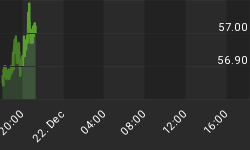This analysis was originally published by The Chart Store on January 9, 2005. The charts have been updated through February 11, 2005.
Among the many books/papers in our investment library is a collection of writings by George Lindsay. One of Mr. Lindsay's techniques was to look for mirror patterns in price action. In this Observation we apply that technique to the unfolding time cycles of the S&P 500.
We begin with a simple weekly bar chart of the S&P 500.

Our first step is to find some important pivot points which we have circled in the following chart.

We apply some labels to the process.

Now the fun part begins. If we count time intervals with the week of the pivot point being 0, an interesting pattern develops.

Chart Notes:
- Focus on the bottom the week of March 14, 2003 (labeled point #5). Go backwards to the high the week of March 22, 2002 (point #4). The time interval is 51 weeks. Now come forward to the high the week of March 5, 2004 (point #4). Again 51 weeks.
- Repeating a similar process, we find the distance between points 3 and 4 both directions is 43 weeks. The point #3 dates are May 25, 2001 and December 31, 2004.
- Fibonacci number advocates might notice that the time differences between the 38 week cycle and 43 week cycle is 5 weeks while the difference between the 43 week cycle and the 51 week cycle is 8 weeks.
- Beginning point #1 date is March 24, 2000 and beginning point #2 date is September 1, 2000.
One pattern that many market technicians have been talking about is an inverted head and shoulders pattern. We have added lines to the following chart which represent our interpretation of that possibility.

To complete the picture, we have added two ovals to our last chart to point out where we are in relationship to the overall pattern. If the market is "reflecting" the past, a correction of several weeks is in order. Points 2 and 1 looking forward are September 25, 2005 and March 10, 2006, respectively.

Summary Points:
- The price and time action of the S&P 500 seems to be displaying "symmetry in motion."
- The mirror pattern outlined above suggests that the S&P has room to go higher into early 2006.
- Does history always repeat? No, but it often rhymes. Or in this case, it just might "reflect."















